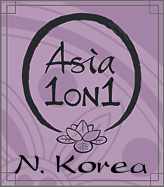|
|
|

Before You Go
| |
Points to Consider In Planning a Trip to North Korea:
Our comments here are directed specifically at Americans, i.e. those holding American passports, as the North Korean officials have requested us to focus primarily on the American market.. As you think about making a trip to North Korea please take a few minutes to read over the points and suggestions outlined below. If you have already thought about and taken into account some or all of them, you are well ahead of the game. If not, please give careful thought to these suggestions based on our decade of experience traveling to the Democratic Peoples Republic of Korea (DPRK) or as it is more commonly called, North Korea. (Click on this hyperlink to see the US Department of State's Background Note:North Korea.)
|
|
|
|
|
|
|
This is the most important point to be aware of since, as an American, you are not normally allowed to visit North Korea except during certain times of the year. (We can arrange for other nationalities to visit throughout the year.) The U.S. government doesn’t have any problem with Americans going (see the US Department of State's Consular Information Sheet.) The U.S. Treasury Department changed the “trading with the enemy” (sorry, that's what its called) rules in 1995 (see the regulation) to allow Americans to go to North Korea and spend money since our own diplomats were beginning to make visits and they didn’t want to have to arrest them on their return. The problem today is that the North Korean government does not allow Americans to visit except during special “windows of opportunity” or while on specially approved delegations. Usually these “windows” occur during holidays or celebrations where they invite the entire international community to come during a several week-long to several month-long period.
|
|
| |
|
|
|
|
The special periods when Americans can visit are usually from August through September during presentations of the Arirang mass performances. Our company, Asia Pacific Travel, Ltd., has been given permission by the Korea International Travel Company (a North Korean governmental organization with whom we have been working for over thirteen years) to bring Americans to North Korea during the window from approximately August 1 through September 30 each year. (See our Letter of Commission.)
|
|
| |
|
|
|
|
The special celebration that will be going on then will be an Arirang Performance that includes a unique show by tens of thousands of performers every night. In the past these performances have included over 100,000 performers singing, playing music, marching, doing mass gymnastics and creating huge “pictures” with colored cards in one of the world’s largest stadiums holding over 150,000 people. The latter “acts” involve approximately 20,000 young people sitting in the opposite side of the stadium like human pixels, each with their own palette of colored cards but acting in unison to create amazing images, some even moving. See examples from previous shows in the Attractions drop-down menu under “Arirang Performance.”
|
|
| |
|
|
| |
|
|
|
|
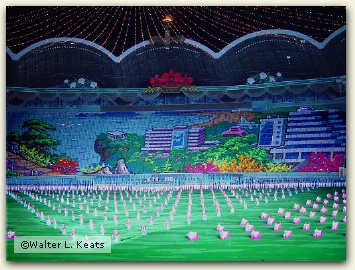
|
|
|
Having said all of the above, there is one important caveat to the “can you visit?” At present the North Korean government restricts the category of “tourists” to citizens of any country other than South Korea. To the best of our knowledge this is because of two main factors. First, they are concerned that most overseas Koreans can speak Korean and would be more likely to interact directly with local North Korean people, perhaps introducing ideas contrary to the government’s official policies and possibly leading to unrest among the populace. Second, a significant number of overseas Koreans have relatives in or from North Korea and would be interested in contacting them, even though they may state prior to their trip that they “just want to see the country.” This creates a large problem for the North Korean government, one that they wish to avoid at this time.
|
|
| |
|
|
|
|
Another category of people who are not allowed to visit North Korea as "tourists" are "journalists". On the DPRK visa form you must list your employer and position. If you have to say you are a journalist, you will not be allowed to visit as a tourist. If you have any questions as to whether this applies to you, please contact us and we will see if this is possible for you.
Top
|
|
| |
|
|
|
|
In our opinion North Korea is not a destination for first-time visitors to Asia unless you have studied one or more of the other Asian cultures. It is a destination for experienced travelers. Seeing North Korea in isolation will not be as educational as seeing it in the context of its other major Asian neighbors, particularly China, Japan, South Korea and even Russia, as these countries have all played significant roles in shaping the North Korea of today. North Korea is not a typical tourist destination. It is not a resort destination. Although it does have beaches, mountains and forests it is not a nature destination. Essentially it is an intellectual, geopolitical, sociological and historical walk through the last one hundred years of Korean history. A visit to North Korea will probably raise more questions in your mind than it will answer, but, if you choose to go, you will have the rare opportunity to see and experience first-hand a little of what life is like in what has been called the world’s last Stalinist, Communist, hereditary dictatorship.
Top
|
|
| |
|
|
|
|
This decision is actually pretty easy. If you want to go, you go when they let you go. For Americans at present this is only during the window of opportunity from about August 1 through September 30. In the past these windows have usually been extended a week or two, but normally too close to the end of the period for most Americans, other than expatriates living in Asia, to take advantage of the extended opportunity.
If you are not an American or South Korean citizen, you can go any time you want, but you can be sure that the winter will be unpleasant, the summers hot and humid, with spring and fall the best weather. On the other hand the Arirang performances are so spectacular and unusual that if at all possible you should try to go during that period so you can see one of these unique memorable performances.
Top
|
|
| |
|
|
|
|
In our opinion, which just happens to work out nicely with air schedules, you should stay in North Korea for one week. For example, if you enter on a Saturday, you should leave on a Saturday a week later. During this time you will have seen most of the major sites that visitors are allowed to see. There are more sites to see, but these other sites require an investment in additional time that is not warranted except for visitors with special interests.
|
|
| |
|
|
|
|
We should mention here that for visitors who just want to truthfully say they “have been to North Korea” it is possible to visit two special areas in North Korea just across the Demilitarized Zone (DMZ). One that has been open since November, 1998 is called the Kumgang Mountains. Tours to Kumgang normally require a minumum 3 day-2 night package due to its distance from Seoul. The other area is the city of Kaesong, an ancient capital of an early Korean dynasty. Day tours to Kumgang started in December, 2007. The Hyundai Asan company runs daily tours from Seoul to these restricted areas in North Korea along the border with South Korea. See our South Korea site for further information.
|
|
| |
|
|
|
|
In addition to the week in North Korea, and with regards to all travel from North America to Asia, keep in mind that with the International Date Line in the western Pacific, you need at least two calendar days to get to Asia, and one day to return so at a minimum you will have three days of travel. In addition you need to get a visa to North Korea which is most conveniently done in Beijing. This will require an extra day. This means that 12 days would be the recommended minimum time for a trip from North America to North Korea.
Top
|
|
| |
|
|
|
|
The big question here is, where will you get a visa? You can not get a visa in the U.S. Visas are most easily obtained in Beijing (you won’t get a visa there either unless you are “pre-approved” before you go) or Shenyang in northeast China. From North America there are numerous flights and numerous airlines serving Beijing. (To enter via Shenyang you may find it more convenient to go via Seoul rather than Beijing.) As stated above, due to the International Date Line, it will take two days to get to Beijing from North America.
Once you have a visa we recommend you fly from Beijing to Pyongyang. There are normally regular flights on Air Koryo, the North Korean airline using Russian planes, from Pyongyang to Beijing and reverse on Tuesday, Thursday and Saturday mornings (and from Pyongyang to Shenyang and reverse on Wednesdays and Saturdays). (Air China is presently operating flights on Mondays, Wednesdays and Fridays using Boeing aircraft.)
At present Americans are not allowed to take the train to or from North Korea to or from China, but even if you are not an American it can be difficult to get tickets for the return journey. Taking the train is certainly a great experience, particularly from Pyongyang to Dandong on the Chinese side of the Yalu River as this occurs during the daytime so one has a great view of the North Korean countryside. Dandong is well worth an overnight as it is the gateway to North Korea from China and has historic sites worth seeing.
Top
|
|
| |
|
|
| |
Helpful Information You Will Want to Know:
The following are various miscellaneous bits of information that you will want to know before you go.
|
|
|
|
|
|
|
Hotels in North Korea are certainly more than adequate. There are, however, no international standard deluxe hotels at this point, and even those hotels that are rated as deluxe or first class in North Korea do not measure up to international standards of first class service. On the other hand the hotels are usually clean, comfortable and utilitarian, if Spartan. Normally, unless you have a preference for a hotel, you will be assigned to a hotel by your status, nationality and economic class. As there is very little vehicular traffic in Pyongyang or other cities our usual concern for location is not very critical here as traffic problems are fairly non-existent. Outside Pyongyang there are even fewer hotels so again, you stay where they put you.
|
|
| |
|
|
|
|
One variant on the theme of hotels in North Korea is in Kaesong where at the Kaesong Folkloric Hotel you can experience the traditional Korean method of sleeping on mats on a heated (ondol)floor.
|
|
| |
|
|
|
|
For more information on North Korean accommodations please click here.
Top
|
|
| |
|
|
|
|
North Korea uses 220 Volt electricity, 60 Hertz. When you check your computer and/or digital camera battery chargers (our main concerns) you will find that most new models work within a 100-220 Volt and 50-60 Hertz range so they shouldn’t be bothered. If you have other electronic appliances that only work on 110-120 V, then you will have to bring a converter.
|
|
| |
|
|
|
|
The biggest concern is the plug types. In North Korea they use a standard, ungrounded two flat pronged plug with both flat prongs being the same size. Many newer North American two flat prong plugs have one larger and one smaller prong, the same as for three-prong plugs, to provide better orientation and grounding. You will need a simple adapter plug to use one of these North American models in North Korea. The key is to have an adapter plug you can plug North American grounded prong plugs (plugs with two different size flat prongs) into, but that will plug into non-grounded plugs (those with two flat prongs the same size.)
Top
|
|
| |
|
|
|
|
Hopefully you are looking forward to having some good Korean food. In general the food in North Korea for visitors is more than adequate. Do not expect to have many gourmet meals in North Korea, however, even with the variety of specialty restaurants in Pyongyang, some of which you can patronize.
|
|
| |
|
|
|
|
For more information on North Korean food please click on the “Cuisine” button on the left panel.
Top
|
|
| |
|
|
|
|
Travel insurance is something that each traveler needs to decide on for themselves. Certainly the least expensive thing to do for healthy people is to "self-insure", meaning you will not purchase travel insurance but will pay for any medical or other costs you might incur out of your own pocket.
For North Korea the situation is a little more complicated and there are, in our opinion, two main considerations. One is "what if the trip is canceled or I am denied a visa?" Normally trip insurance won't cover these situations as they are considered "soverign risk". To resolve this situation, should it occur, Asia Pacific Travel's (APTL) policy is that if a trip is cancelled by North Korea or by APTL (due to insufficient number of participants), or a participant is denied a visa to China or North Korea, then APTL will refund the participant's entire payment with no penalty. Thus, there is no need for "trip cancellation" insurance on APTL's tour packages.
On the other hand there is still the problem of insuring for participant's medical problems along the way, or problems for friends or relatives back home. If you have reason to believe that either of these situations may occur during your tour, you will have to decide whether you want to self-insure or purchase trip insurance. Trip insurance can cost 8-10% of the tour cost. Another option, if you can self insure, is to have medivac insurance. This can be for one trip or on an annual basis. An annual policy for a family of three costs between $250-300. One of the major companies in the travel insurance field that we use is Travel Guard.
Top
|
|
| |
|
|
|
|
Visitors to North Korea normally have two guides. You are not supposed to leave your hotel without one of these guides so you will most likely not be traveling on any local transportation by yourself. In Pyongyang there is a subway, called the Metro, and there are local buses, trolleys and taxis. Normally tourists are taken on a short ride on the Metro so they can see the ornate stations, similar to those in Moscow.
Top
|
|
| |
|
|
|
|
Keep in mind that internationally you are limited to 20 kg. (44 pounds) or less in coach class air travel. We would certainly suggest one travel light in North Korea. You are unlikely to see any family, friends, colleagues and/or neighbors there who could report back on your less than perfect sartorial elegance, so “if a person dresses averagely in the forest will anyone notice?”
Top
|
|
| |
|
|
|
|
Normal photography is not a problem in North Korea but one needs to be sensitive. Photographs of military subjects should be discouraged without permission. Photographs of scenes that might reflect badly on North Korea should be avoided, again unless given permission by your guides. Extra large camera lenses and/or binoculars can draw suspicion and should be avoided. Film is available in North Korea, but it is probably best to bring your own.
Top
|
|
| |
|
|
|
|
With respect to money, North Korea is primarily a cash economy since it is one of the safest countries in the world. Bring cash, in US Dollars, Chinese RMB, or Euros as credit cards are only useable in the hotels, some times. Cash is also better than travelers’ checks as there is an extra service charge to cash travelers checks. There are no ATM machines. There is no need to change money since anything you will want to buy will be denominated in Euros or Korean Won and you will not be given any Korean Won (it is presently illegal to take Korean Won out of the country.)
Unfortunately, unless something changes dramatically there aren't many souvenirs to purchase, and those for sale are not very expensive, unless you are looking for real "art" pieces which can range into the thousands of dollars. Bringing several hundred dollars, i.e. US$200-500, per person should be more than adequate, assuming you are on a prepaid group tour. If you are not on a tour and will have to pay for all your expenses in the DPRK, then you will need a lot more cash.
The following images are of "real" North Korean currency. Although not available in the DPRK they are readily available across the border in China.
Top
|
|
| |
|
|
|
|
DPRK 1 Won note (front), 1992 issue, showing the heroine from the North Korean revolutionary opera, "The Flower Girl".
|
|
| |
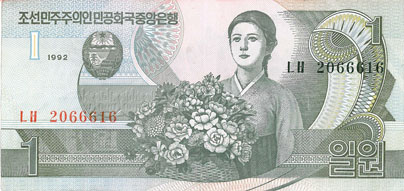
|
|
|
|
DPRK 1 Won note (back), 1992 issue, showing the famous Kumgang (Diamond) Mountains of southeast North Korea. See our " Kumgang Mountains " web page for additional information.
Top
|
|
| |
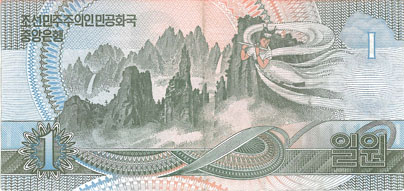
|
|
|
|
DPRK 5 Won note (front), 1998 issue, highlighting education.
|
|
| |
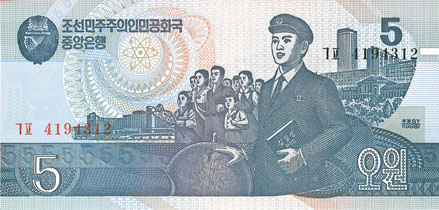
|
|
|
|
DPRK 5 Won note (back), 1998 issue, showing the Grand Peoples Study House, located in central Pyongyang. See our "Grand Peoples Study House" web page for additional information.
.
Top
|
|
| |
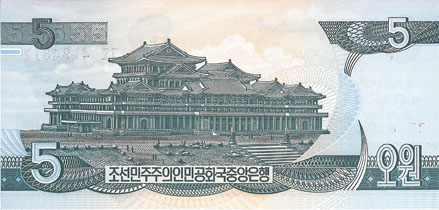
|
|
|
|
DPRK 10 Won note (front), 1998 issue, hightlighting industrial development. In the background is a statue of the Chollima, a mythological horse, able to cover 1,000 ri (about 400 km.) per day, and used as an image to exhort the North Korean people after the devastation of the Korean War to rebuild their country in record time. See our "Chollima Statue" web page for additional information.
|
|
| |
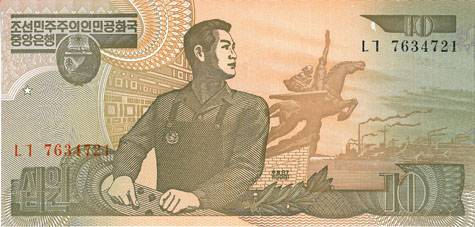
|
|
|
|
DPRK 10 Won note (back), 1998 issue, hightlighting one of the major engineering feats of North Korea, the West Sea Barrage in Nampo, at the mouth of the Taedong River that flows southwest from Pyongyang to the Yellow Sea. See our "West Sea Barrage" web page for additional information.
Top
|
|
| |
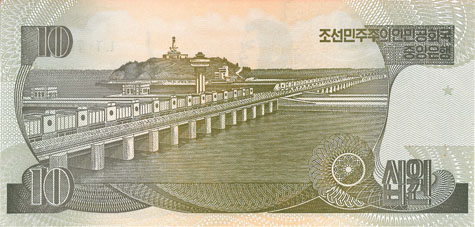
|
|
|
|
DPRK 50 Won note (front), 1992 issue, showing the categories of people in society, the workers, peasants and intellectuals. In addition it shows the Juche Tower, commemorating Kim Il Sung's philosophy of "self-reliance". See our "Juche Tower" web page for additional information.
|
|
| |
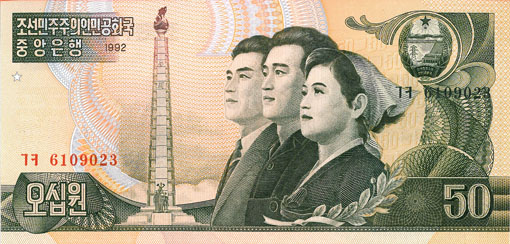
|
|
|
|
DPRK 50 Won note (back), 1992 issue, showing Mt. Paektu (called Changbaishan by the Chinese), a famous mountain on the border with China. It is said that Kim Jung Il was born at a secret camp on this mountain during the anti-Japanese guerilla campaign.
Top
|
|
| |
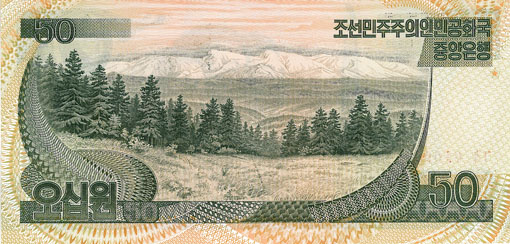
|
|
|
|
DPRK 100 Won note (front), 1992 issue, showing an image of Kim Il Sung.
|
|
| |
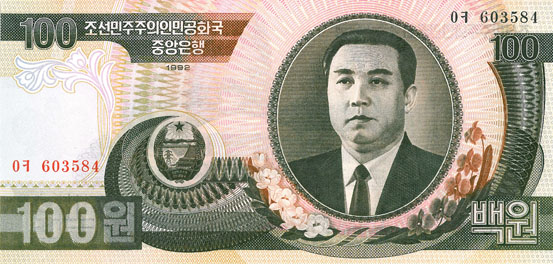
|
|
|
|
DPRK 100 Won note (back), 1992 issue, showing Mangyongdae, the birthplace of Kim Il Sung in the southwestern Pyongyang. See our " Mangyeongdae " web page for additional information.
Top
|
|
| |
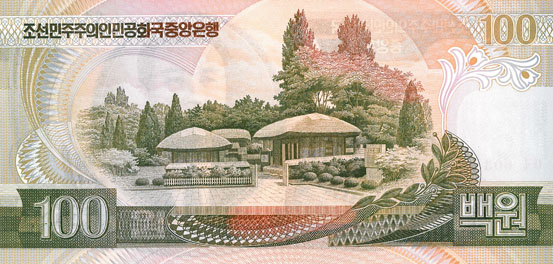
|
|
|
|
DPRK 200 Won note (front), 2005 issue, showing the national flower, the Siebold's Magnolia.
|
|
| |
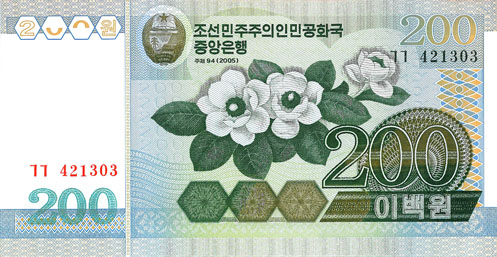
|
|
|
|
DPRK 200 Won note (back), 2005 issue, reflects a change from the pictorial images of previous notes, and shows only variations on the figure 200.
Top
|
|
| |
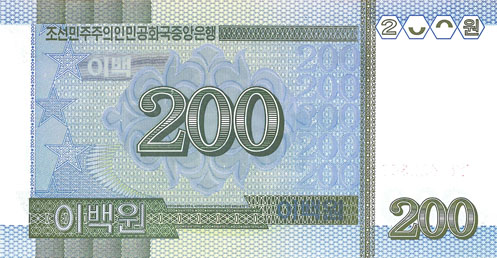
|
|
|
|
DPRK 500 Won note (front), 1998 issue, showing Kumsusan Memorial, the final resting place for Kim Il Sung, formerly his office and residence.
|
|
| |
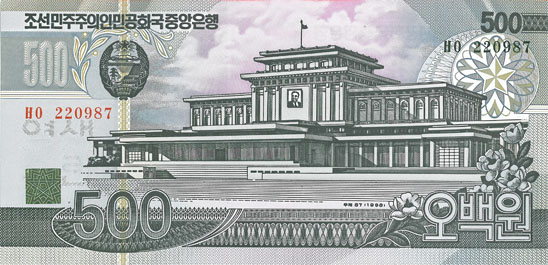
|
|
|
|
DPRK 500 Won note (back), 1998 issue, shows the modern Chongnyu Bridge across the Taedong River in central Pyongyang. The bridge extends from the east side of the river and of Pyongyang to Rungna Island, site of the huge May Day Stadium the largest stadium in the world, seating over 150,000 people.
Top
|
|
| |
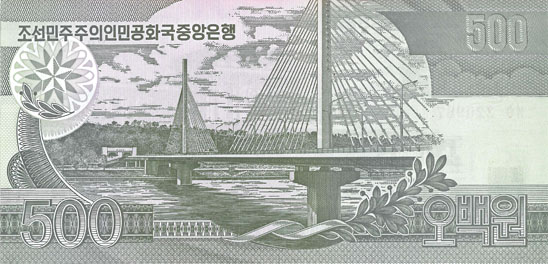
|
|
|
|
DPRK 1000 Won note (front), 2002 issue, showing an image of Kim Il Sung.
|
|
| |
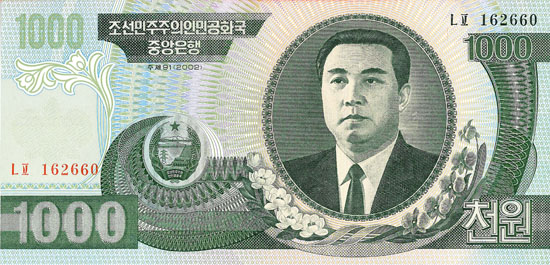
|
|
|
|
DPRK 1000 Won note (back), 2002 issue, showing Mangyongdae, the birthplace of Kim Il Sung in the southwestern Pyongyang. See our " Mangyeongdae " web page for additional information.
Top
|
|
| |
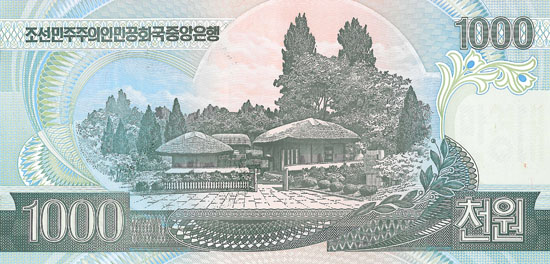
|
|
|
|
DPRK 5000 Won note (front), 2002 issue, showing an image Kim Il Sung.
|
|
| |
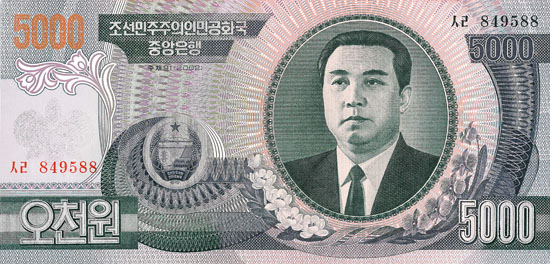
|
|
|
|
DPRK 5000 Won note (back), 2002 issue, showing Mangyongdae, the birthplace of Kim Il Sung in the southwestern Pyongyang. See our " Mangyeongdae " web page for additional information.
Top
|
|
| |
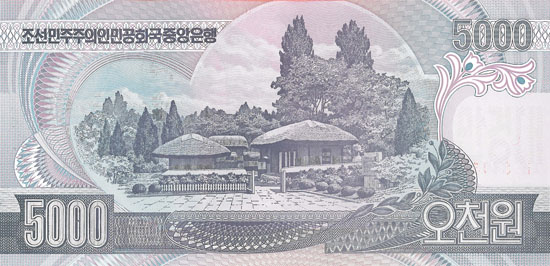
|
|
|
|
All of North Korea is in one time zone, UTC/GMT +9. It does not use daylight savings time.
This means that North Korea is 15 hours ahead of Chicago standard time (UTC/GMT -6), 14 hours ahead of East Coast standard time (UTC/GMT -5), and 17 hours ahead of West Coast standard time (UTC/GMT -8).
From April to October in the U.S. North Korea is 14 hours ahead of Chicago daylight savings time (UTC/GMT -5), 13 hours ahead of East Coast daylight savings time (UTC/GMT -4), and 16 hours ahead of West Coast daylight savings time (UTC/GMT -7). North Korea is on the same time as South Korea and Japan, and 1 hour ahead of China (UTC/GMT +8).
Top
|
|
| |
|
|
| |
For specific tour itinerary planning contact Asia Pacific Travel directly.
|
|
|
|
|
|
|
Asia Pacific Travel, Ltd. � P.O. Box 350 � Kenilworth, IL
60043-0350 USA
Tel: 1-(847) 251-6400 � Toll Free: 1-(800) 262-6420 � Fax: 1-(847) 256-5601
NorthKorea1on1.com is a registered trademarks of Asia Pacific Travel, Ltd. |
|
HOME |
Who We Are |
Contact Us |
Press/News |
Travel Agency Services |
|
|
|
